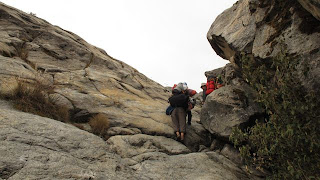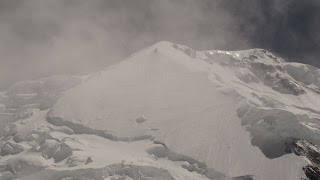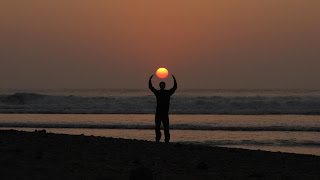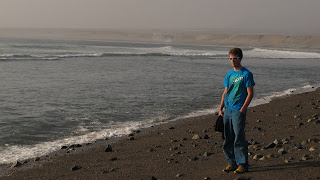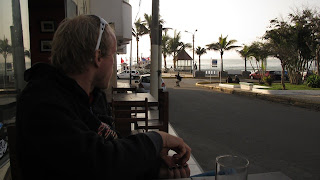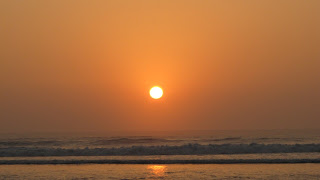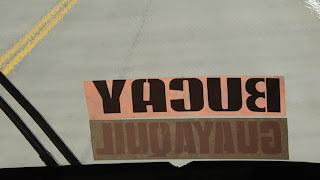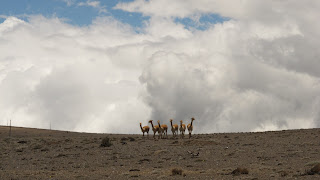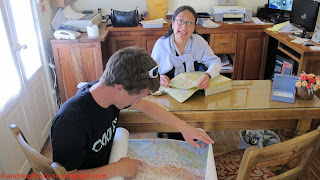Outer adventures
Saturday, October 15th, 2011
Huascarán 6768 m – An alpine style solo ascent on Peru’s highest mountain followed by some fun skiing
How the dreaming started
When I was a kid and went to high school most of my life surrounded skiing. Every time I got to choose a project I tried to angel it in some way towards skiing, mountains, climbing or some kind of physical or physiological subject that would strengthen me for the adventures I saw was forth coming.
I remember so well how I managed to twist one geography project into a work about avalanches. Not that I was particularly interested in the dangers of avalanches back then, it was more that I wanted to find places to dream about go skiing.
I learnt that the deadliest avalanche in the world came down a huge mountain in Peru (Mt Huascaran) in 1970, killing more than 20 000 people and leaving many more homeless. Shocked as I was about the devastating natural forces I still got impressed by mountains so big that they where able to create something like that. If they are that huge they must also be capable of serving great adventures, so thats where the dreaming started.
The old masters
Along the way I also started reading up on the old masters of mountain skiing and i came over this extract written by Parick Vallencant about the first ski descent of Huascaran. Check it out here: pistehors.com/backcountry/wiki/Bio/Patrick-Vallencant (scroll down the page till you get to the Huascarán part)
Huascarán north and south seen from Mucho
The Adventure
With all this in mind we stumbled in to the mountain town of Huaraz a week ago. On our journey through south america this has been planned as a stop and it has been the mountain that has been bugging my mind the most.
First of all we are here on probably the worst time of the year. The normal climbing season of this mountain is between june and august and the autumns are infamous for lots of precipitation, storms and bad weather. Swedish adventurer Fredrik Sträng literarily told me that we are going to get in trouble if we go here at this time when I talked to him this summer. If the weather was not going to take us, it was going to be lots of snow, hard winds, no other people and possible avalanche danger.
Secondly its not that easy of a mountain to get up on. Its the 7th highest mountain in south america and the highest in Peru. Out of the ten highest peaks on the continent this is definitely the one with the hardest normal route and as a bonus its highly crevassed and threatened by seracs a good part of the way. Its also, for the record, the second point furthest from the center of the earth, after Ecuador’s Chimborazo.
I mean, if we would have been here during the normal climbing season with sufficient amount of time I wouldn’t have been to worried. But on our optimistically packed itinerary through the Andes this have definitely been the theoretical crux of the journey.
So it was with great respect and with some anxiousness that I approached the mountain last saturday. The weather forecast told us we would have about three days of bad weather before a possible window of high pressure. That felt perfect as we had understood that the approach was fairly long and we needed time to gradually move up our camps to properly acclimatize and to have a good position when the weather window (hopefully) would come.
We took a local mini bus from Huaraz to Mancos early saturday morning. We got squeezed in the back with our gear and could hardly move during the one hour ride. Once in Mancos we managed to take a taxi up to the little village of Mucho on the foot of the mountain. The driver knew, of course, exactly where to let us of and before we knew it we got fed in someones home while waiting fore mules and porters.
I have never used either mules nor porters before but we knew it would save us a few days worth of energy on the mountain as well as its helping out the locals who can make way over average local income on us gringos.
So of we went up the beaten track towards the Refuge Don Bosco at 4800m. Its an almost 1800m vertical rise from the village and we where really glad we had our two new found local friends and two mules to get our heavy backpacks, food for 7 days and ski equipment anywhere near the start of the fun.
It took us about five hours to get to the refuge. As I said before we where here kind of of season and we read in the guestbook in town that the last climbers who sat their foot on the mountain where there more than two months earlier so of course the refuge was closed.
We slept one night outside of the hut and then we continued on our own up to camp one at just below 5200 m. Everything went well but Bjarne got really worked by the second day. And getting really worked and trying to acclimatize to your new altitude sleeping-record does not go hand in hand so he was feel really bad.
The weather was as promised – low pressure with precipitation but not much wind. On the third day we took a rest day in camp 1 so Bjarne could hopefully recover to move up higher the next day. But as experienced before, if you get worked at altitude and you are not acclimatized to that point, recovery goes dead slow, as does further acclimatization.
So Bjarne was feeling the altitude and was really tired and was only slowly getting better leaving moving up to camp 2 a no option. The weather was slowly getting better and we would have our window soon, but I was by my self from here on. To get Bjarne in shape to move up higher we would first have to get him lower down but we didn’t have enough food and fuel to get him rested and then go up again on this attempt. And we where not able to move up camp; leaving an about 1600 m vertical distance of totally unbroken, snowy and crevassed terrain between me and the summit. A total suicide at first view, but after some consideration a small chance of success and a gift given to me in the shape of an adventure so big that I didn’t know if i would be able to handle it. In other words, I would need to dig deep again.
The snow that had fallen had gotten really warm in the day and then refrozen during night. This would mean the lower part of the face got relatively safe in the night and early morning. On the forth day I took of at three in the morning to scope the route with the help of the full moon. But I had a really bad gut feeling and the clouds came in; darkening the mountain making it almost impossible for me to see where to go in the maze of seracs. I wasn’t at all worried about falling in to something as the snow was rock hard and i where on skis, but it would simply take to long time negotiating the way and at the same time the gut feeling told me something was terribly wrong.
I took my skins of and skied back to the tent and went to sleep. Two hours later we both got waken up by a roar from the mountains. At sunrise when I woke up again I could se the track taken by the debris on the lower parts of the normal route where I would have been if i would have kept going.
This is the game of objective dangers we all play on the mountains where ever we are in the world and what ever kind of objective we have. Some mountains are, of course, more dangerous than others, but still; either if we believe in the religions of statistics or faith its a fact we need to live with. The number one rule is still to always, always listen to your gut feeling. Its a rule that have both theoretical, meta- and quantum-physical as well as logical reasons, more on that later.
Waking up on this, the forth day, for the second time it was to become a great sunny day. I ate my second breakfast and took of again up the mountain. I took my time to scope a good way and I self belayed and tested every snow bridge i didn’t fully trust. It was a huge work to create a “safe” route up the lower 900 m of the mountain. But after a twelve hour work day I had made a route up the lower slopes of the mountain up and around to the col between the north and the south summit. I was totally done physically but it felt like the whole enterprise could be done on a good day. I understood directly though that the normal route was not an option as it was to long and also the upper half was highly crevassed. The strategy had to be changed according to the circumstances but I had high hopes in my new plan.
The fifth day on the mountain I hardly leaved my sleeping bag except for eating and going to the men’s room. I was fully worn out, but I knew from the last springs adventure in Alaska that I have the means to recover in a short period of time. The next night i could hardly sleep, my whole body felt energized and ready to perform and at one thirty I just jumped out of my sleeping bag, ate my porridge and took of in the night.
What had taken so much time two days earlier payed of now. I cruised around the seracs and black holes in the dark and gradually gained altitude. Instead of taking the the normal route up the mountain I had decided to take the most direct line up the classical ice face of The Shield. A 600m ice face (grade D+) that starts half way up the face. Up higher I knew the snow would be getting deep and by climbing an easy ice route I would save lots of energy.
After two hours of climbing i started feeling nauseous and now and then I had to just lie down on my ice axes and force myself to not throw up the energy i would need later on in the day. My stomach started fighting its own little war and two times I had to run in to a crevasse and throw my harness of and take a shit. Fortunately I had taken some toilet paper with me, otherwise it could have gotten nasty.
At dawn i found my self at the start of the shield and I celebrated by opening a can of tuna that would, as it seems, save the day. After eating the fish with my knife I started feeling better and with the sun came the warmth and some new found energy. Happily i started up the face that started up at 60-65 degrees with two short steeper steps. I got really impressed by the americans that claimed to have skied this ten years ago. Then again, much change in ten years on ice faces and at this time i was going to enjoy 600 meters of brittle ice, i was really happy I had ski boots that would relieve the calves. Doing this with climbing boots would have been a nightmare.
I slowly gained altitude and I had to be careful with my placements in the ice that notoriously cracked in big plates and fell down in to the abyss. After what seemed like an eternity I arrived at a small plateau for a short break and gave Bjarne a shout on the radio.
“Good work Andreas, you are about one third of the way up the Shield.”
That was not really what I had hoped to hear after what had felt like such a long time of hard work. But the angel eased up the higher I came and i switched over to my ten-ten method. This means i take ten steps, then lie down on my axes for ten seconds and then repeat this till I get where I want.“Persistence is favorable”, says the old proverb and in the end you get where you want in climbing as long as you persist, even if it may feel like an eternity sometimes.
After some hours I was up on top of the Shield on a sharp ridge that would lead me to the summit plateau.
Now came what would be the next test. Wallowing in knee deep snow that would break down in plates almost broke me down mentally. I took two steps up and sank down one. This is enervating on a mountain near you, but on over 6300 m by myself it took all i had to get up this ridge. Instead of ten-ten i had to do three-twenty at times.
The whispering little voice in the back of my mind armed with negative thoughts got stronger and stronger. The scary feeling of tears loading up in the throat preparing to start crying was building up. I didn’t have much more in me and going beyond where you have been is always scary. Fright implies the unknown. And now what I didn’t know was if I was going to have the strength to get back down again.
After ten hours of climbing I finally arrived at the top plateau. It was midday and it was a stellar day, but the wind was chilly. I had all my clothes on started walking on the flat. It was boot deep snow and it was really hard work. I took a few steps and then lay down on the snow like a wounded animal, got up on my feet – to soon again, fall down on my belly.
Fear filled me with doubt. At least I had really given it a good try, but now its time to turn back. Andreas, you can still be proud of what you have achieved today. You have gone beyond where you have been before. I got tears in my eyes, and it felt like I could touch the summit, but I could not have it. What an internal fight!
After have gotten maybe 50 meters in half an hour I got an idea. I threw of my backpack and put my dromedary bag and some powerbars in my pocket. I ditched everything i didn’t needed on the spot and carried on upwards on my skins. It may seem like an obvious thing to do now, but it felt like breaking a mathematical formula there and then on the mountain in that exhausted state.
It was the classical scandinavian fjeld scenario during the next two hours. I would get close to a small knoll that I would think is the summit and then when I got there there would be another one behind. And when I got to the next one another one would still be there teasing me behind this one.
But in the end there where nothing more behind the last knoll than the view of the Peruvian mountains in the south. When I looked back I could see the classical mountaineering peaks in the north as well as Huascaran Norte. Everything below my feet.
I fell down in to a pile of muscle, bones, clothes and equipment. I didn’t know what I had left. I really didn’t know. I took a few photos with my camera, pulled of the skins from under the skis. Buckled up the boots and started cruising down. It was not a beautiful sight. All my old students from my time as a ski instructor would have smiled at me thinking, Andreas, now you’re not living as you are teaching. But at that moment, I couldn’t have cared less.
I got back to my pack and put it on together with my Go Pro, and then continued down towards the ridge that had been such a hard work. I really didn’t have a good idea how to get down this mountain. I skied a few turns, and then sat down hyperventilating, skied a few turns and then sat down to catch my breath. Skiing was dead easy, like most of the time, it was just the art of breathing that was hard. At least my headache was starting to leave me and it got easier to concentrate. On my right i had a fifty degree slope for two hundred meters of really hard snow. I knew that if i wait half an hour i would tear that one up in big turns when the sun had done its work, but I was to tired to bother – I just wanted down.
I slid down without making turns for 100 m, then thought if looked blue further down, so i changed to crampons walked down 50 m and then realized it was easy skiing. The half hour had passed and made the snow soft. It was such an amateur thing to do, but then again I was tired – like hell.
I took of my jacket and didn’t bother putting the camera back on. I jumped the bergschrund and started to try to find a way down through the seracs with poor Bjarne trying to helping me out from below. Together we actually worked it out and it only took me about fifteen minutes to ski down to my old track and it was really good skiing in a magical steep glacier environment.
I doubt this line have been skied before even though it feels much more natural than the normal route, it gives really good quality skiing and its the easiest and most direct line on the mountain. No down climbing or rappelling needed. Maybe a 5.3, D+ or something like that.
The snow got softer and softer the lower down I got and when I was back on my old tracks I didn’t have to think about much anymore. I cruised the last part on autopilot and crashed down at Bjarne’s feet at the tent. It was with great relief and surprise that I sat down to have dinner with my good friend watching the sunset.
We slept another night in our tent and woke up early the next day to ski down the glacier, and walk down to Mucho. The 2200 vertical meters took us about five and a half hour plus a two hour break at the refuge. Someone had broken in to the hut so the guardians where there cleaning and restoring it when we passed by. They invited us for lunch and we sat down enjoying the great Peruvian hospitality below their crown mountain in the warm spring sun.
Well back in Huaraz we are enjoying rest and good food and are trying to catch up on work. We will stay here for one or two days and then continue south, always south!
For more info on Huascarán, check these links out:
Shitheads:
Andreas: 22
Bjarne: 24
In the bus to Mancos
In Mucho
Our donkey and our horse
Some scrambling
A night outside of the hut
Bjarne Sahlén
Bjarne climbing the slabs
And the glacier
Our camp
Huascarán north and south
The Shield
It was quiet warm in the tent…
Just another self belay
Bjarne working
Breakfast
Our ongoing shithead tournament
The moon at dawn on my summit push
Taking a rest
Climbing
The summit ridge
On the top
Looking south from the top
Looking north from the top
Back down in camp
Bjarne skiing down
In the cab on our way back to Huaraz
In town the same night
Saturday, October 8th, 2011
South towards Peru; surfing in Trujillo and expedition planing in Huaraz
Peluche managing the sun
Today we arrived in Huaraz after a beautiful voyage down the coast by bus. We arrived yesterday morning in Trujillo and had the day to spend before leaving again in the evening for Huaraz.
The choice was easy, we jumped on a taxi down to the coast, hired some boards and went surfing. It was a wonderful day in the ocean followed by great seafood and peruvian ice. Early this morning we arrived in Huaraz and have spent the whole day shopping, sorting out park fees, permits and packing. Now we are set to go up in the mountains again tomorrow. We have food for seven days with us, so you might not hear from us in a while!
Shitheads:
Andreas: 13
Bjarne: 10
Our bunker room in Guayaquil
Another breakfast on the way. We haven’t found good coffee on the whole trip so far
An old Volvo bus got us from Guayaquil to Trujillo
Leaving the pirate town
Happenings on the way…
Our luggage room in Trujillo
This dude knew whats important in life
Bjarne relaxing by the water after a day of surfing
This was not us, but I would say Peluche got pretty close!
Bjarne putting in some working hours on the bus
First glimpse of the Cordillera Blanca
Packing session late at night
Wednesday, October 5th, 2011
Guayaquil
The ventilation system is running wavelike in the roof. You can hear the air going through the shack in the middle of the building but we can’t look out. We don’t have a window. The walls where once white, but are now brownish and there is a distinct smell of smoke that fade away after some time in the room.
There is no way of running away from the heat and the humidity in this place. The panic might come creeping, but there is really no way out, so just go with it! Feeling the heat and the pulsating beats of air from the vent system gives me a desire to meditate and a friendly helping hand in to reality.
It feels like we have sailed in to a pirate port in a time long ago and are now enjoying the ups of civilization life after months at sea. In reality we have just arrived to Ecuador’s financial capital and biggest city; Guayaquil. After a five hour bus ride from Riobamba on winding roads from around 3000 meter above sea level, up to over 4000 and then down all the way to the Pacific ocean in a wild chicken race kind of lap against tractors, trucks and kids with death as the only viewable end for the ones that loose.
Still, this feels like a place lost in time and a no place to be for anyone resembling a gringo. The white folks are hiding in fear of reality at the posh hotels and the streets are pulsating with life so naturally human that anyone in fear of dirt will instantly run away. The real life takes it turns out on the streets and anything that goes is a good idea in the game of surviving. Old ladies selling ice cream out of black plastic bags, young boys running around with Coca Cola bottles selling coke by the glace and many others hunkering up on the side of the streets selling whatever they have found worthy looking at.
We are wandering the town in search of the adventure. Everyone we ask where to go tells us Hotel Continental is the only safe place for us gringos. Over there they have 24/7 security and we will not have to worry. After a wonderful chinese dinner we loom after some colombians to check Continental out.
We order two beers and sit down to watch some baseball. After half an hour we are bored out of the sterility of the hotel and wander out. On the way we find out that those two beers where more expensive than the dinner we just had.
It is said that allergy doesn’t exist in farms where the children constantly get in contact with the bacterias from the animals and the dirt. Some kind of connection with that thought hit me when I walked out from the hotel – the only place in town where gringos feel safe.
In the lonely planet book its said that if you are out in town after dark you should take a cab even if only going one block. All the information we get seems to be bathing in fear. Anyways, we left everything worth stealing in our bunker of a hotel.
We head towards the darkest alley we can find in search of finally getting robbed. No guns or knifes anywhere to be seen. Instead we get searched up by two climbers from Mendoza. They liked to go down to the ocean where we a couple of hours before found that pirate ship that came to symbolize this town.
Bjarnes stomack says no, so we run for the hotel. A night in fantasy and fables is coming to an end. I’m mostly happy for not paying the bus driver the three extra dollars he tried to scam us on when we arrived. And sad for the black taxi dude who got caught by the police when driving us to the the terminal terrestre. He paid 25 cents to drive us to the bus terminal from town – that doesn’t feel fair.
Shitheads:
Andreas: 5
Bjarne: 3
Sleepins:
Andreas: 1
Bjarne: 2
The view from the bus
Pit stop
Bjarne “Peluche” Salhén is rocking salsa style
Fires in the streets of Riobamba
Monday, October 3rd, 2011
Chimborazo – A long night on Ecuador’s highest mountain and some amazing skiing close to the equator
“Bjarne, dont fall asleep!”
“Ehh, no, I wont!”
15 minutes later:
“Andreas, are you sleeping?”
“Mmm.”
These are extracts from my and Bjarne’s conversations last night. And its not from a normal flatmate discussion, but from a scene where we are both leaning on our ice axes on a mountain side with our faces in the snow somewhere between wake and slumber.
Chimborazo, some say it’s the biggest thing you’ll ever see…
We are on our first stop on our South America adventure – Ecuador’s 6310 m high Chimborazo, also famous for being the point furthest away from the center of the earth (thanks to the ovality of the planet around the equator).
During the last week, most of our concentration and time have gone to this mountain. There are different game rules here in Ecuador from what we are used to back in Europe. The mountains are higher and you can take a taxi to their doorstep. Weather service is by no means exact and the bacterial flora in the food is often much more hardcore than we are used to. It also have to be added that the climbing season on this mountain is December-January and June-August, leaving us on the mountain alone with the worst weather pattern of the year.
We came here with good self confidence but with the second thought in mind that many of our good mountain friends been slapped in the face by the Andean mountains. This was kind of our warmup and acclimatization object of the trip so maybe we where taking it a bit to lightly.
We started in Quito one and a half week ago by going up to the volcano Pichincha at 4800 m twice. Then we took the 2,5 h bus ride down south to Riobamba and right away from there a taxi up to the Carrel hut at the foot of Chimborazo at 4850 m. From here we walked up to about 5300 m just to keep on breathing the thin air. The following days promised excellent weather so we thought we go for it the next day in a on day push with an really early taxi from Riobamba. This was almost a good idea, but just almost. We got up to 5400 m when the sun hit the face on an exposed section and the only sober thing to do was to turn back down before the rocks strated raining. It was a petty though as we where feeling our strongest so far on this trip. Had we taken the taxi one hour earlier in the morning I think we would have made our way to the summit. We thought we make another try the following night, but we where both (me more than Bjarne) feeling really bad from the altitude so we hitched back down to town first thing in the morning. We where totally exhausted from this little adventure and needed three days of rest before we could even think about another try. But three days later the weather in the night looked ok and we thought out another fresh strategy.
We took the taxi at six o’clock PM from Riobamba and arrived at the park entrance gate at seven thirty. The rock n roll park service didn’t at first want to let us through, mainly I think because we didn’t hire one of their local guides, but after some negotiating and showing of Bjarne’s business card we finally was let through. We went straight in to the hut and made us some dinner and two hour later, at about ten PM we took of aiming for the summit of Chimborazo.
Ten o’clock is really early to take of on this mountain. The guides with clients usually starts at around midnight, but we started from the lower hut at 4850 m (most people start from the Whymper hut at 5000 m) and we didn’t feel really well acclimatized for the almost 1600-1700 m climb up to 6310 m, which is more than 100 m higher than Denali. And do I need to add, we wanted it badly this time, optimizing everything we could.
So we where walking through the night (yes, lets call it a walk. I counted three or four climbing moves during the whole walk up and down). Everything went smooth, but pretty slow. Its said that it take a week at altitude before the body even starts making more red blod cells, that are one of the more important factors in long-term acclimatization. 1,5 weeks after coming from sea level and living at 3000 m and climbing above 6000 m is hardly enough for any kind of performance. But then again, time on altitude is what we have lots of for the remaining part of this adventure.
It was a clear night with almost no wind and we where steadily gaining altitude. I was in front and Bjarne followed. The pace was set on such a slow pace that we would be able to get enough oxygen thorough the body while still taking that step upwards. But each 15 minutes, when we took a brief break to drink, we fell down on our knees resting on our ice axe, and on the later part of the night, almost fell asleep.
We had to dig deep within ourselves to get anywhere and at around 5700 meters four o’clock in the morning Bjarne had had enough. He was feeling really sick from the altitude, and we agreed that he was going down. I was feeling worried leaving him by him self in the darkness, but we had our radios on and we where on snow which meant i would be able to ski down to him in a matters of minutes.
I kept on upwards having one of the toughest fights in my life with myself. I had to gather all the concentration i had to just gain a few steps and in between I was lying on my ice axe trying to breath. But slowly, slowly I got higher and soon i felt like I was on the top of the first snow dome, the lower Ventemilla summit. I told Bjarne I was almost there, almost on the summit, but it would take another hour before i stood on the top. But I was not done yet. I still had to ski down about 50 vertical meters and then climb up on the true, Whymper summit. This was the physiologically most demanding thing on the whole
undertaking – to, in a very beaten condition at altitude, put myself in a position where I couldn’t immediately ski down if i started to feel too sick.
But I kept at it, and in the end i stood at the top just after dawn, alone on a volcano a little bit south of the equator, after one of the most mentally demanding things i have done in my life. Its by no means, on the paper, close to one of the hardest things I have done in the mountains. However, combining the physical condition I was in (worn out), the timing and degree of acclimatization I must say I was extremely relived standing on the summit and also breaking my personal altitude record (It has to be added that Bjarne broke his own altitude record for every step he took above 5300 meters).
After skiing down from the Whymper summit and working my way back onto the Ventemilla summit I once again clicked in to my bindings and buckled up my boots. I hadn’t been skiing since I was on Mt Byron in the coastal range in Alaska together with Greg Collins, Magnus Kastengren and Heidi Adamson in june. And it was with a tired but happy smile i took of down the west face in big turns.
Far below my ski tips I had the clouds and desert like lowland of Ecuador. Even though seven in the morning the sun was heating up my face and I was really enjoying the warmth when I now and then had to lie down to catch my breath.
Further down the snow got harder and I had to take it a bit easier, but still enjoying every turn I felt i had earned. Bjarne stood waiting for me at the snowline and all in all i got over 700 vertical meters of skiing in the falline and a great experience from a beautiful mountain.
I got one sad surprise though, when coming below the snow line. My climbing boots that we had hidden under a rock was gone, like everything else we have left unattended on this trip. I guess I shouldn’t blame anyone but myself leaving a pair of boots worth a months wage (for someone with a good job) out on the mountain.
Maybe it was the hardest earned 700 meters of skiing in my life. But the skiing, this time, came as a bonus. The real reward was the secrets I found within myself in the calm and painful darkness. More on that later. Now we are back down at Hostal Oasis in Riobamba and we are looking forward to I night out celebrating in town tonight before we hop on a bus tomorrow – direction south towards Guayaquil and then Peru!
This would be hippie if back home…
And this would not be legal
And these would be exotic
Chimborazo in normal late september weather
Bjarne making early morning porridge
Our happy taxi driver. Bjarne cant get over that he stole our chips!
Protection in the hut
Waiting time in the hut on our first attempt
Sun set in the Ecuadorian mountains
Late drive to the mountains. Now I know enough Spanish to bargain – we got this one for half the price!
Bjarne eating dinner in the dark
Chimborazo @ night
Bjarne @ night
The Whymper summit, the highest summit on Chimborazo, and of course in Ecuador
View from the top
View from under my skis
A tired Andreas
Bjarne walking down in the clouds
The big reward!
Sunday, September 25th, 2011
Down south in Riobamba
Today is a rest day in the charming city of Riobamba. I’m still feeling really down and a bit sick, but I’m hoping a day of rest will set me back on track.
I would have done this update earlier, but Internet has been down in the whole country of Ecuador for the day. And then to make it even more adventurous, the electricity went out for a couple of hours.
Yesterday we took the three-hour buss ride from Quito and it feels like we are starting to have the real Ecuador experience. Lots of people we meet seem to be worried we will get in trouble with all our gear, but so far we have only met really friendly people. The only problems we have had have been to find restaurants with big enough portions to still our hunger. A normal evening we have gone to one restaurant, and when we are done we just look at each other, and one of us will say; “ok, so shall we go to the next place”…
Life seem much more grounded and real over here than back home. The chaotic nature of the human mind appear to realise it self in the everyday life in a totally different way than the often repressed feelings in northern Europe. Traffic is flowing in a confused disorder, but everyone seems to get where they are intending to go. Life on the streets and the everyday life flow with the “anything goes” attitude. It’s poverty everywhere, that gives me a simmering feeling of guilt, but the lively eyes from the people on the streets quickly takes a way that feeling and replaces it with; sure we are rich in things and “thinks” (yes, intellectual thoughts) but these people have a richness in grasping life that we back home doesn’t even come close to.
Last night we teamed up with our newfound friend Charlotte from the Netherlands and went out on the local market to buy vegetables for dinner. It ended up being one of the liveliest experiences in our lives. In the dusky light under the market’s grand roof with no lights, the play of this Latino bazaar played it self out in the shadows. The aroma of fresh vegetables, meat, fruit and spices blended together and the only light came from the glowing eyes of the shop keepers and their children that where playing under and around the tables. The local Quichua dialect and Spanish where the only languages to be heard and there was an instant delight and laughter when I tried to get by with my 4 day old Spanish (mixed with some French) with some help from Charlotte. I chose to not take out my camera, because I could see the change in faces when Bjarne captured the moment on film. Instead I will always remember the playfulness and curiosity in the small kids when they came to meet us with high fives and questions on where we where from.
If I feel stronger tomorrow we will try to find a taxi that can take us up to the mountains. Its been raining heavily in the last few days, so I’m concerned for the avalanche danger up high. But if we are lucky what creates fear in my mind right now will create joy while making turns in Ecuadorian pow-pow.
Quito @ night
B-man, playing it cool
On the buss to Riobamba…
Riobamba @ Night
Bjarne and Charlotte
Sunday in school
Saturday, September 24th, 2011
Everyday workouts in Quito
The last two days Bjarne and me have worked the neighbourhood as good as possible for thin air. The town itself is located around 2800 meter above sea level and just being here is good acclimatisation. But a good thing with Quito as a pre-climbing destination is that there is a gondola in town taking you up to 4100 meters. From this viewpoint you can get an additional 700 meters by a easy 2h hike to the summit of Cumbre Rucu Pichincha. We have now done this hike two days in a row and have been hanging out on the summit for a few hours working on our Spanish, listening to music, talking about life and just freezing in general.
But Quito is of course not only mountains; it’s a really cool city with very friendly people. In between our workouts we have been strolling the town, eating some good food an trying to get info about further transports south.
Tomorrow is a rest and travel day south to the higher mountains. It’s going to be exciting to see the big Ecuadorian lumps of snow, rock and ice but the weather doesn’t look very good. However I have found a window in the next few days, so if we are lucky we will get into what we came here for.
I’m very tired after the long journey and the last two days. Bjarne flew in one day before me and had time to sleep in, but I really feel the lack of sleep even though the body have been feeling incredibly well on altitude. Coming from sea level to 4800 meters can feel like a shock, but so far I haven’t even got any bad signs.
Now we are of for our last night in Quito. Bjarne is keen on samba; lets see where this is going!
First dinner in Equador
Bjarne in the gondola
“No bandidos aqui ahora” said the guard at the lift station while imitating being stabbed in the belly…
The first view of Cotopaxi and the real mountains in Ecuador
Thursday, September 22nd, 2011
The Denali film!
Here is the edit from my adventure on Denali this last spring… Enjoy!
Edited by Bjarne Salhén on endlessflow.posterous.com







